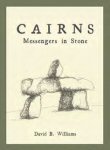SEJournal Online is the digital news magazine of the Society of Environmental Journalists. Learn more about SEJournal Online, including submission, subscription and advertising information.

Book Shelf
Cairns: Messengers in Stone
By David B. Williams
The Mountaineers Books, $15.95
Reviewed by KAREN SCHAEFER
David Williams confesses that it was once as much a part of his job to destroy cairns as it was to build them.
In the 1990s, Williams worked as a park ranger at Arches National Park in southeastern Utah, where meandering trails in the barren sandstone landscape are marked by small, stacked piles of rocks, to keep hikers on the path and off the fragile terrain. Williams says he frequently found hiker-made cairns that redirected foot traffic to areas the NPS was trying to keep pristine. These he carefully dismantled.
That human urge to build wayside markers is the premise for this slim volume, which briefly surveys the long history of building markers in stone. Using a park ranger-style delivery, shot through with equal measures of science, storytelling and humor, Williams takes the reader on a world tour of cairns, both ancient and modern. He speculates that cairns may be one of humankind’s oldest forms of communication. But he says cairns as trail markers are just one of their many uses.
Throughout human history and across the globe, Williams recounts how cairns have been built to commemorate an event or a person, like a now-vanished cairn in Stockbridge, Mass., believed to have been built in honor of a long-dead sachem; to celebrate a religious ritual, such as those still built by Buddhists in Mongolia, called oboos; even to mark the burial of the dead, as evidenced by the many European Bronze Age passage graves covered with stones and earth.
Some of the most fascinating tales Williams tells are of prehistoric cairns built by hunters to help drive game. In the American West, for instance, these were often simple piles of rocks placed by prehistoric Native Americans to funnel bison down a narrow arroyo or over a cliff. Williams also regales readers with stories of expedition cairns, meant to leave behind a record of the fate of explorers of previously-unmapped territory. Included are stories of the tragic Scott expedition to the South Pole and the hunt for Sir John Franklin, an English nobleman who disappeared in the 1840s while sailing the North American Arctic searching for the Northwest passage.
A geologist by training, Williams is even lured by his inner geology nerd to discuss the best rock types and methods to build a cairn, the niche ecology of cairns (including a story about how certain types of oak trees in Israel grow only out of ancient cairns), and a fascinating take on how modern science is learning to date cairns through rock patina, lichen growth, and bioluminescence.
Designed more as a trailside companion than a compendium of cairn histor y, Williams’ book is nonet heless a delightful and often surprising look at this ancient human practice.
Karen Schaefer is an SEJ member and freelancer based in northern Ohio.
* From the quarterly newsletter SEJournal, Spring 2013. Each new issue of SEJournal is available to members and subscribers only; find subscription information here or learn how to join SEJ. Past issues are archived for the public here.













 Advertisement
Advertisement 



